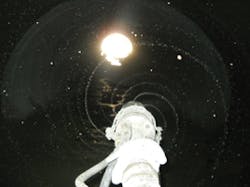When Robert Kincaid, P.E., city engineer for Jerseyville, IL, heard about a two-lane paved road failing in his jurisdiction, he wasn’t overly concerned at first. The road was slumping in lanes, with some small sinkholes just off the pavement due to a failing corrugated metal pipe (CMP) storm sewer running underneath the road, but cities deal with this kind of failure all the time. However, a closer look revealed serious challenges.
This was a 60-inch by 100-foot-long CMP sewer in very bad shape; the invert was more or less completely rotted out, much of the pipe’s top arc was also failing, and the road slumping was caused by a wide gap near the middle of the sewer run where sewer sections were out of horizontal alignment by about 8 inches. And this sewer had limited staging areas, with a golf course on the south end and a treatment plant evaporation pool just 20 feet away on the north end, leaving about a 14-foot pad for equipment. So, trench-and-replace seemed like a bad strategy; Kincaid says. “Altogether, it would have been a horrible and costly dig for us.”
Looking for alternatives to trenching, Kincaid first thought of cured- in-place pipe (CIPP), but found that contractors were reluctant to even bid on such a large-diameter repair, and when they did, “The price seemed extremely high.” So he began “scouring the Internet” and came across CentriPipe, a spincasting solution from AP/M Permaform that sounded promising.
CentriPipe is a centrifugally cast concrete pipe (CCCP) trenchless repair technique that has been proven over a decade or more and has been approved for use by many departments of transportation and other large agencies. But it doesn’t always come to mind readily for most municipal engineers.
The CentriPipe process relies on a precisely controlled spincaster, pulled through pipe to apply high-strength cementitious grout in thin, even layers. This creates, essentially, a brand new, structurally sound concrete sewer within the old, failing sewer. Because the new pipe is thin (2 inches or less in most cases) and adheres tightly to the old substrate, pipe capacity is only minimally reduced. Because it’s concrete, waterproofing or anti-microbial agents can be mixed in as part of the rehabilitation, if needed. Perhaps best of all, staging area requirements are modest, trenching is avoided, and CCCP is exceptionally cost-effective compared to CIPP and similar solutions.
Jerseyville selected Ace Pipe Cleaning Inc., headquartered in Kansas City, MO, as its CentriPipe contractor. Bryan P. Dobson was the operations manager, and Jackson Lewis was the onsite project manager.
An Unpleasant Surprise
Dobson bid and planned the -CentriPipe project based on photos, and when he arrived in Jerseyville on a Monday morning, he discovered a difficult challenge. “Photos taken in a wet season showed the pipe bottom covered with what looked like a shallow flow, of course,” he explains. “But in September [2014], when we showed up with everything we needed to get started with rehabilitation, we discovered that the seasonal flow had obscured a ‘canyon’ running along the bottom of the sewer—the CMP had failed so completely along the invert that erosion had created a three-foot-deep trench along 40 or 50 feet of the sewer bottom. That was a surprise for us and the city.”
A smooth bottom is needed for CentriPipe spincaster withdrawal, so most projects require some sort of resurfacing. In this case, Kincaid worked with a local batch plant to make a pumper truck available on short notice, and on Tuesday the Ace crew was able to fill in the eroded trench with 10 cubic yards of digable fill, which they then topped with a few inches of sprayed and troweled PL-8000, a high-strength, workable engineered cementitious product from AP/M Permaform. After a solid day’s work, they had the smooth strong surface they needed to begin spincasting the next day; in the area of the 8-inch gap, they filled in and beveled to make an even transition. Dewatering was accomplished with coffer dams and a 2-inch pump. To complete pipe preparation, sewers are usually scoured with high-pressure spray (sometimes with the CentriPipe spincaster), and some hand-troweling of pitted or peeling sewer sections is usually needed.
Work began on Wednesday morning with the placement of depth pins; because the cement layers applied are thin, it’s important that each layer be applied evenly. Ace uses a standard rivet gun to set aluminum rivets at 12:00, 3:00, 9:00, and (sometimes) 6:00 (viewing the pipe diameter as a clock face), every 20 feet or so along the sewer, then trims the rivets to an inch. This gives CentriPipe sled operators a good visual gauge of thickness as layers are applied and, at project end, ensures that the final design thickness—1.5 inches in this case—has been reached. For a redundant check on final thickness, Ace also tracks material volume used; in Jerseyville, about 4.5 pallets were used, translating to an applied volume that exceeded design specifications.
One important detail to work out before spincasting begins is winch placement. “We knew when we started working with this system that we needed a good, flexible way to place and anchor the withdrawal winch,” explains Dobson. “So we built a ‘winch skid’ out of planks and angle iron that can be carried by two people. If we’re working from a grass surface, we can drive rebar to anchor the skid, and if we’re on pavement we can set lag bolts through the angle iron and patch up the holes when we’re finished.” On this particular project, because inline placement of the winch was difficult, a pulley arrangement had to be improvised so that the winch could be withdrawn in a straight line through the sewer.
Even with all this preparation, the first layer of PL-8000 was applied on Wednesday. Because the material cures quickly—within a few hours—new layers can be applied on successive days. In Jerseyville, two 3/4-inch layers were applied in two days. Hand-troweling for a smooth bevel at the entrance and exit transitions completed the CentriPipe work. “We’re getting better at doing the spincasting right to the sewer entrances,” says Dobson. “But still, mainly for looks, we find that hand troweling and brushing is necessary to really finish off the ends well.”
Final cleanup, walkthrough, and inspection was performed by Kincaid on Friday morning, completing the sewer rehabilitation on schedule, even with the surprise “canyon” to fill. In fact, Kincaid had been visiting the site regularly during work. “He stopped in every few hours to take a look and check the pins,” says Lewis. “And he even brought by some of the local engineers to come see how things were progressing.”
For his part, Kincaid says he is well pleased with Jerseyville’s first CCCP project. “We had actually used a similar technology for manhole rehabilitation,” he says. “So I had a good idea that CentriPipe would work here. Still, it was a pleasure to see it go on so well and, four months later, I’ve walked through twice, once after a major rain event; it appears to be holding up perfectly. We’ll inspect again after winter, but right now I believe this has been the right solution for us.”






